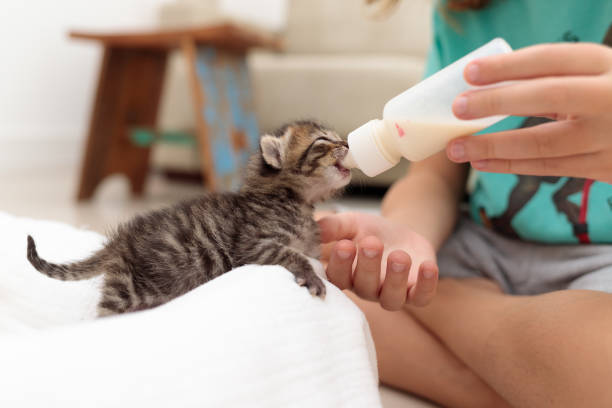Newborn Kittens
Your cat has given birth to a litter of kittens. Now is the time to step in and help her care for them. But be very careful: your mother cat is fragile at this stage, and you could do more harm than good if you interfere as she gets used to her kittens.
New Kitten Care
The first two to three weeks are the most crucial for a mother cat and her newborn kittens. The kittens should be developing rapidly, and the mother will usually show symptoms of any postpartum problems by this time.
Keep the mother cat and her babies in a quiet part of the house; a separate room is ideal, and make sure the room is warm. Chilling is one of the most critical dangers to newborn kittens.
Let the mother cat set the pace for your attention. If she is a longtime companion and resident, she may welcome your visits. A rescued stray or fostered cat may prefer that you stay away for the most part. As long as the kittens are nursing frequently and appear to be thriving, they will be OK.
Use a large enough box to comfortably hold the mother cat and her kittens. Stack clean towels to line it. The towels will become soiled quickly as the kittens defecate and it will be easy to remove the top towel to reveal a clean layer.
Keep the mother cat’s litter box, food, and water bowls close by, and continue to feed her a high quality canned kitten food, supplemented with KMR (Kitten Milk Replacement).
Health Threats to Kittens
Health problems in young kittens fall into three categories: infectious diseases, such as respiratory infections, diseases caused by parasites, and certain congenital diseases. Of the latter, one of the most well-known by people involved in rescue and fostering is Fading Kitten Syndrome.
This condition, which may have multiple causes, occurs when a kitten fails to thrive. If you notice one of the kittens in the new litter sleeping a lot more than its siblings, and is generally lethargic, these may be signs of FKS, which requires immediate attention from a veterinarian who specializes in kittens.
Elimination
For the first three weeks, the mother cat will lick each kitten around the abdomen and anal area after nursing to encourage the elimination of waste. In her absence, this task would be yours and would be accomplished with a warm, damp washcloth.
Development of Newborn Kittens
Their eyes will start opening within three days. The umbilical cord will also fall off within this time. Their nervous systems are not fully developed and you will see them twitching during sleep. This is entirely normal and indicates the development of their nervous system and muscles.
The kittens will start crawling around and by two weeks they will be attempting to stand. Their teeth will begin to come in during this time. You will be able to feel tiny nubs.
By three weeks the kittens will start walking around and actively playing. They can be introduced to wet food at this time, supplemented with KMR, though they still will be actively nursing. They may also be introduced to the litter box at this age, with the caveat to avoid clumping clay litter.
The Vet Well-Check
After the first week, take the mother cat and kittens to your veterinarian for a well-check. If she was not vaccinated, this is a good time to do so. Also, she should be given medication for roundworms, to protect both the mother cat and her kittens.
Of course, if she or the kittens show any symptoms of problems before a week passes, take them to the vet immediately.
Potential Problems for a New Mother Cat
There are a few conditions to look for in the new mother cat.
Mastitis is an infection of the mammary glands, which occurs when the mother cat’s milk production is heavy and milk is retained. The teats become swollen and hot, with “bruising” apparent, and the mother cat may refuse to allow the kittens to nurse. Mastitis is a veterinary emergency, and the kittens may need to be hand-fed until the mother cat has recovered.
Hypocalcemia, also known as “milk fever,” is rare in cats, and is caused by lack of calcium during pregnancy and nursing. Symptoms include seizures, staggering, muscle tremors, restlessness, and excessive panting. Hypocalcemia is also a veterinary emergency. The kittens will need to be fed by hand until the mother is recovered.
Endometritis is a serious infection of the uterus and is also a veterinary emergency. Although the mother cat will have normal vaginal drainage after birthing her kittens, a foul-smelling discharge is a red flag. Other symptoms include lethargy, fever, and loss of milk production.
The mother cat may have to be hospitalized for treatment, and emergency spaying may be needed. Again, it will fall on you to feed and care for the kittens in this case, with either the Kitten Glop or KMR.
In all likelihood, none of these problems will occur, and your mother cat and her newborn kittens will thrive.
Related Articles
Tips for caring for newborn kittens
Whether you are a seasoned cat rescuer or someone who just happened to find an abandoned litter of newborn kitties under your porch, we hope you’ll benefit from these useful tips. They were provided by [...]
Momma Mia! 7 Important Tips When Caring for Momma Cats and Kittens
Last week we had one very pretty, very pregnant momma cat who decided to deliver her kittens right there in the trap upon her arrival at our clinic! First bit of good news, all five [...]

